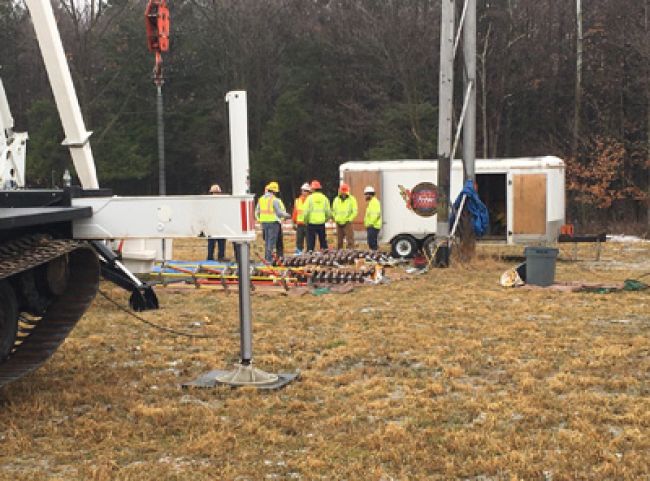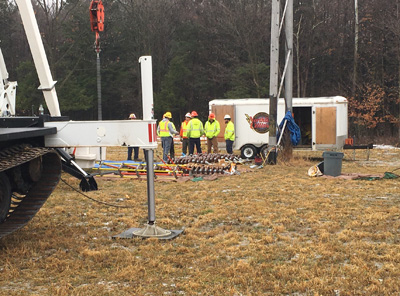
Recognizing Our Human Risk Factors

Determining the root cause of an incident or accident gives us the opportunity to share lessons learned to help prevent future duplication of the event. In this article, we’ll identify those inherent human traits that seemingly have little to do with the tasks lineworkers perform but often are the cause of incidents. It’s difficult to mitigate risk if we don’t recognize it, so let’s explore how simply being human can set traps for us.
Inattentional Blindness
Before we go any further, please be interactive here. Log onto your computer and plug in https://youtu.be/KB_lTKZm1Ts. The link will lead you to an awareness test during which you simply count the number of passes one team makes in a 15-second basketball game. Spoiler alert: If you haven’t watched the video yet, don’t read any further until you have.
OK, did you finish taking the awareness test? Good – let’s continue. When you focused on the basketball game in the video and performed the required task, it’s highly likely you missed seeing a person in a bear suit moonwalking across the center of the court. So, what happened? Did you lose focus and concentration? Of course not – you were very focused on the task at hand. Missing the moonwalking bear can be chalked up to a common human condition referred to as inattentional blindness. It is a natural occurrence that can be mitigated by forcing yourself to stop and look at the big picture. But unless we know inattentional blindness exists, it’s hard to mitigate the risk.
Last year dozens of children died in the backseats of cars where they were forgotten. That seems impossible, right? These types of things can never happen to us. It’s always someone else – until it isn’t. Sometimes we as humans miss things, and sometimes those things we miss can lead to incredibly hazardous situations. On the bright side, if you missed the moonwalking bear in the video, the odds are you won’t miss it next time. With that said, if you don’t have a strategy to make sure you don’t miss it, it could happen again. To paraphrase Oliver Wendell Holmes, a mind stretched to a new shape never regains its original shape. Prepare to stretch your mind to consider the risk you bring to every job just because you are human.
We’re Designed to Take Shortcuts
There are things we are never taught. We get a sampling of biology, math and history in school, and then, if we enter into a trade, we learn hard skills. If you are a lineworker, I can ask you a few questions that almost every lineworker can answer. What are the voltage limits of your rubber gloves? What’s the arc flash rating of your FR clothing? What’s the weight limit on that digger winch? The answers to those questions are clear. How about this one: What are the limitations of the human brain?
We are told over and over again not to take shortcuts on the job. But the fact of the matter is that humans are naturally designed to shortcut everything and stereotype people and conditions just so we can navigate life. Think about when you got out of bed this morning. If you had to think about which foot to take out of bed first, and which hand to use to hold your toothbrush, and how to put the toothpaste on the toothbrush, and which sock to put on first and which route to take to work, you would still be at home. Add to this the conservative nature of your brain; it turns out that your brain hacks a good majority of your so-called free will. It uses a liter of blood per minute and runs on 20 percent of the air you breathe and 40 percent of the food you eat. Further, your brain does not store energy. It allows tasks that are familiar to run almost automatically on a lower energy budget. Just as with your car, there is a fuel limit in your brain. For instance, on your way to work today, you were thinking about almost everything except driving, right? Have you ever missed an exit while listening to music or talking on your Bluetooth? I thought so. The good news is that if you know you are doing a repetitive or familiar task, you can override your brain’s tendency to shortcut you. Checklists and slow, deliberate thinking can bring you to a more accurate self. Before you start a familiar task of potentially high consequence, make sure everyone on your team knows the risk is high because it’s a familiar task. Too often you will hear, “I’ve got this, I’ve done it 1,000 times.” That is a red flag for increased risk.
Six Heuristic Traps
Now that we’ve explored how easy it is to miss something you’re not looking for, let’s take a look at what is driving your behavior and decisions.
In the early 2000s, researcher and educator Ian McCammon began a research project that assessed the behavior of avalanche victims. Over time he identified six heuristic traps – errors in judgment – that can affect the human decision-making process. These traps are familiarity, consistency, acceptance, social facilitation, scarcity and what is referred to as the expert halo.
Familiarity
Those tasks that we do repeatedly require the least amount of thought. We begin to do them automatically, and that is the trap. When you have always done something the same way, there’s a well-worn groove in your brain to perform the task. You are unlikely to see subtle changes that have occurred or are occurring because, as with driving, you are only partly paying attention. The cure to the familiarity heuristic is to use the STAR (Stop, Think, Act, Review) system when doing anything of high consequence. Your fast, automatic brain is not as accurate as your slow brain. Slow, deliberate review of your surroundings and plan will help improve outcomes. It almost sounds too easy, but when you are plugging along at a task you’ve done so many times before, it can be hard to stop.
Consistency
Consistency is the heuristic that makes you keep plugging along. It’s the error you make when you are trying to fix something and keep at the same plan until you either make the problem worse or break whatever it is you were trying to fix. Think about climbers on Mount Everest who keep going because they have been marching toward the summit all day, only to finally reach their goal and perish because they have no reserve to get down the mountain. Consistency drives us to continue a failing plan instead of regrouping and changing the plan. We can fall prey to it because it is our nature to plow through even though things are not going well.
Acceptance
Acceptance occurs when the group is heading in one direction and you don’t want to be the one to speak up and suggest a different direction. We all want to be accepted by the group. We don’t want to be the one to spoil the plan or appear as though we’re not a team player. If we can help create a culture where it is OK to speak up even if we are wrong, the world will be a safer place. Someone has to be the one to ask the question and politely articulate their point of view or concern. Someone else has to listen.
Social Facilitation
Social facilitation is the tendency for people to behave or perform differently in the presence of others. The dynamics of the social hierarchy often hold people back from speaking what is really on their minds. But once you learn that familiarity, consistency or social facilitation may be driving the group toward disaster, you will be obligated to point it out. Addressing social facilitation starts with speaking up and not caring what the perceived consequence might be. When your focus is trying to impress the leader in the group, you have succumbed – sometimes subconsciously – to this heuristic trap.
Scarcity
Scarcity is in play when something is perceived to be in short supply. Our brain then accepts more risk and prepares to shortcut. For example, when you leave late for work and time is scarce, you are more likely to take greater risks and shortcuts on your way to the job. Or, when it starts to get dark and your foreman yells, “Hey, we are running out of daylight, let’s get this done,” your subconscious immediately begins working on a shortcut, even if you are not consciously aware of it. If we are truly trying to be proactive and prevent incidents, it would be more appropriate to make a safety stop at dusk to identify and address the natural tendency for the group to take shortcuts to beat the fading light.
Expert Halo
The expert halo is particularly dangerous. If you are competent at what you do, or in charge, or if you are dressed like you know something, other people will defer the risk to you as the expert. Remember, the human brain is conservative, so it will pass off risk to someone else every chance it gets. If you have ever directed traffic at a work site or an accident scene, you may have noticed the drivers seem to be getting dumber. That’s because they have passed all the risk to you as the person in charge. In passing that risk, they wait for you to make all their decisions for them. Workers in lead positions wear the expert halo. They must engage the group by asking questions to gather consensus and input. If they don’t, the group will drift off, assuming the leader has their backs.
What Can You Do?
This is just an overview of some of the mental traps that are waiting for you. These human conditions must be part of hazard identification in your job brief. If the job is routine, a red flag should go up. Use a checklist so you don’t miss something. When something changes – such as weather, crew makeup or a shift from daylight to darkness – take a moment to regroup and use teamwork to identify new risks that may result from the change. When your crew member tells you that he spent all night up with his sick child or is having a family health crisis, bring it to the forefront so that everyone can help that employee succeed, or give him the day off if the work is critical. The fact is, thinking slowly is more accurate and analytical, but sometimes our fast-thinking self convinces us we are thinking slowly. If you want to be sure, collaborate with a co-worker to double-check your thought process.
So, now that you know your decisions are being hacked, take a deeper dive into the things you may be missing in your job brief. Look out for these things before you live the consequences they can cause. Identify the hazards and mitigate all the risks – including yourself.
About the Author: Bill Martin, CUSP, NRP, RN, DIMM, is the president and CEO of Think Tank Project LLC (www.thinkprojectllc.com). He has held previous roles as a lineman, line supervisor, project manager and safety director.
Editor’s Note: If you’d like more information about this topic, Martin will present “It’s Easy to Miss Something You’re Not Looking For: Critical Thinking and Situational Awareness for Electrical Safety” on April 30 at the iP Utility Safety Conference & Expo in Denton, Texas. Visit https://utilitysafetyconference.com for more information and to register.

